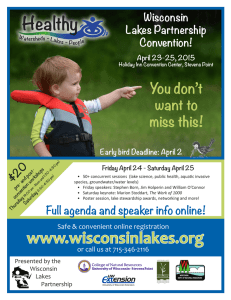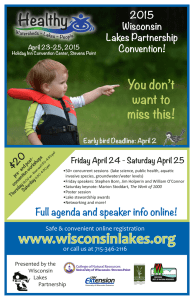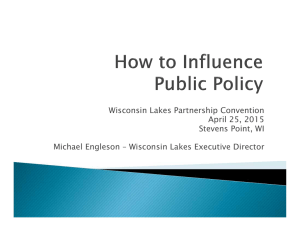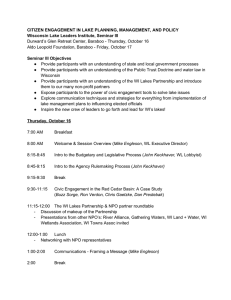LOCAL BOATING AND RECREATIONAL USE MANAGEMENT
advertisement
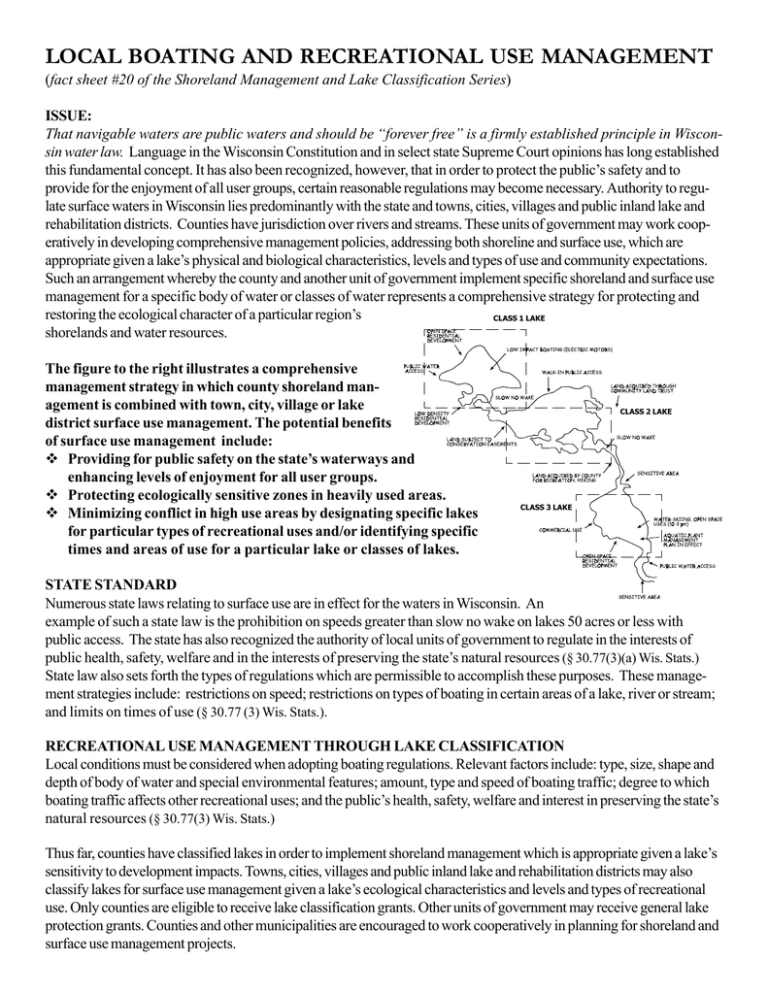
LOCAL BOATING AND RECREATIONAL USE MANAGEMENT (fact sheet #20 of the Shoreland Management and Lake Classification Series) ISSUE: That navigable waters are public waters and should be “forever free” is a firmly established principle in Wisconsin water law. Language in the Wisconsin Constitution and in select state Supreme Court opinions has long established this fundamental concept. It has also been recognized, however, that in order to protect the public’s safety and to provide for the enjoyment of all user groups, certain reasonable regulations may become necessary. Authority to regulate surface waters in Wisconsin lies predominantly with the state and towns, cities, villages and public inland lake and rehabilitation districts. Counties have jurisdiction over rivers and streams. These units of government may work cooperatively in developing comprehensive management policies, addressing both shoreline and surface use, which are appropriate given a lake’s physical and biological characteristics, levels and types of use and community expectations. Such an arrangement whereby the county and another unit of government implement specific shoreland and surface use management for a specific body of water or classes of water represents a comprehensive strategy for protecting and restoring the ecological character of a particular region’s CLASS 1 LAKE shorelands and water resources. The figure to the right illustrates a comprehensive management strategy in which county shoreland management is combined with town, city, village or lake district surface use management. The potential benefits of surface use management include: ! Providing for public safety on the state’s waterways and enhancing levels of enjoyment for all user groups. ! Protecting ecologically sensitive zones in heavily used areas. ! Minimizing conflict in high use areas by designating specific lakes for particular types of recreational uses and/or identifying specific times and areas of use for a particular lake or classes of lakes. CLASS 2 LAKE CLASS 3 LAKE STATE STANDARD Numerous state laws relating to surface use are in effect for the waters in Wisconsin. An example of such a state law is the prohibition on speeds greater than slow no wake on lakes 50 acres or less with public access. The state has also recognized the authority of local units of government to regulate in the interests of public health, safety, welfare and in the interests of preserving the state’s natural resources (§ 30.77(3)(a) Wis. Stats.) State law also sets forth the types of regulations which are permissible to accomplish these purposes. These management strategies include: restrictions on speed; restrictions on types of boating in certain areas of a lake, river or stream; and limits on times of use (§ 30.77 (3) Wis. Stats.). RECREATIONAL USE MANAGEMENT THROUGH LAKE CLASSIFICATION Local conditions must be considered when adopting boating regulations. Relevant factors include: type, size, shape and depth of body of water and special environmental features; amount, type and speed of boating traffic; degree to which boating traffic affects other recreational uses; and the public’s health, safety, welfare and interest in preserving the state’s natural resources (§ 30.77(3) Wis. Stats.) Thus far, counties have classified lakes in order to implement shoreland management which is appropriate given a lake’s sensitivity to development impacts. Towns, cities, villages and public inland lake and rehabilitation districts may also classify lakes for surface use management given a lake’s ecological characteristics and levels and types of recreational use. Only counties are eligible to receive lake classification grants. Other units of government may receive general lake protection grants. Counties and other municipalities are encouraged to work cooperatively in planning for shoreland and surface use management projects. A classification system for surface use should be based on specific in-lake characteristics and input from a broad crosssection of the community. For each of the criteria listed below, a lake may be assigned a point value. These points are later tabulated to arrive at a total lake score. EXAMPLE: Criterion Surface area Shallowness Ratio (%area less than 10 ft in depth) Classes less than 200 acres 200-1000 greater than 1000 acres Points 3 2 1 Commentary most vulnerable greater than 50% 25-50% less than 25% 3 2 1 Mesotrophic(2-4 meters) Oligotrophic (greater than 4 m) Eutrophic (less than 2 meters) 3 2 1 system in flux/vulnerable 3 2 1 high boat pressure least vulnerable negative impacts on vegetation sediment resuspension minimal Water clarity Public access (Admin. code NR 1.90-1.92) Greater than state access code standards within access code less than state access code boat impacts minimal low boat pressure Existing development 11-100 dwelling/mile shoreline 101-500 500+ Aquatic Macrophyte Community Index (AMCI) Greater than 45 35-45 less than 35 3 2 1 3 2 1 low pier density high pier density plant community diverse disturbed plant community Maximum points possible=18 Minimum points possible=6 This system represents a model which can be modified by the lake community. Another model which could be considered is the system used for county shoreland classification. This classification system may be used to make a preliminary assessment as to where local boating regulations to protect ecologically sensitive areas or lakes may be appropriate. Lakes which rank high may be considered for whole lake boating restrictions, special use regulations or slow no wake zones. Lakes which rank low may have minimal restrictions, or not need boating ordinances for environmental purposes. Specifics with respect to ordinance adoption will not be covered here. The publications listed below should be consulted for additional information on ordinance adoption, enforcement and related issues. References and additional sources of assistance: Bureau of Law Enforcement. 1992. Guidelines for Ordinance writing and Buoy Placement in Wisconsin Waters. Wisconsin Department of Natural Resources. O’Connor, William. 1997. Local Boating Regulation in Wisconsin. Wisconsin Association of Lakes. Drafted by Tamara Dudiak-UWEX Lake Specialist (715-346-4744); tdudiak@uwsp.edu; Contributions from Timothy Asplund, Bureau of Research,Wisconsin Department of Natural Resources and John Lacenski, Bureau of Law Enforcement, Wisconsin Department of Natural Resources. For more information, contact your regional Department of Natural Resources lake coordinator, the Wisconsin Association of Lakes [800/542-5253] or UWEX/UW-Stevens Point [715/346DS/LAKECLASS/FS-20.PM5 2116].
